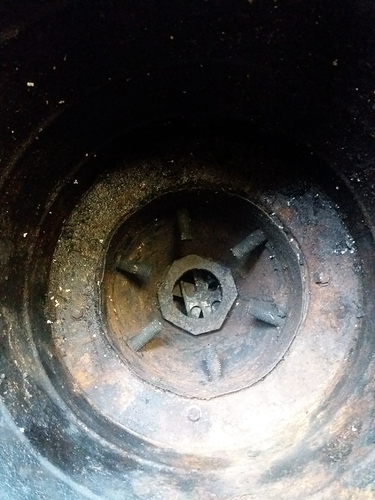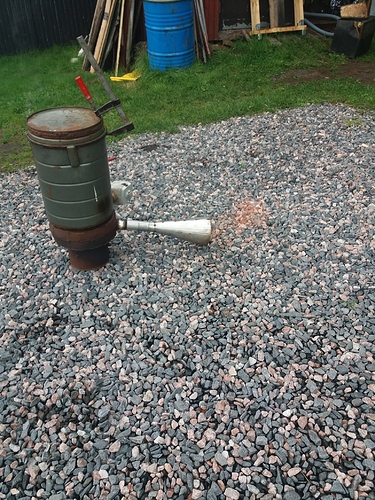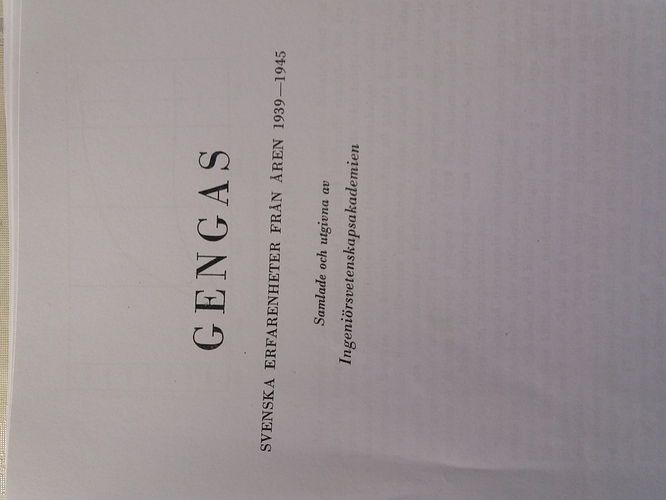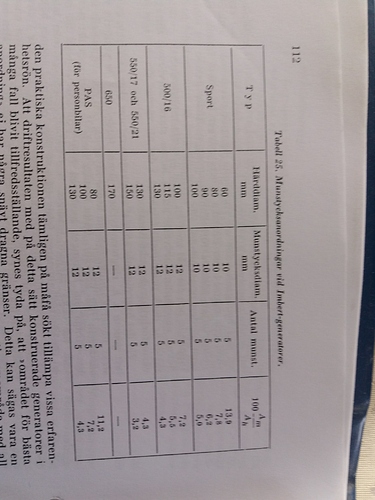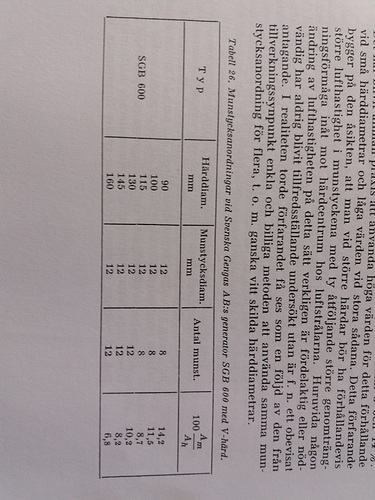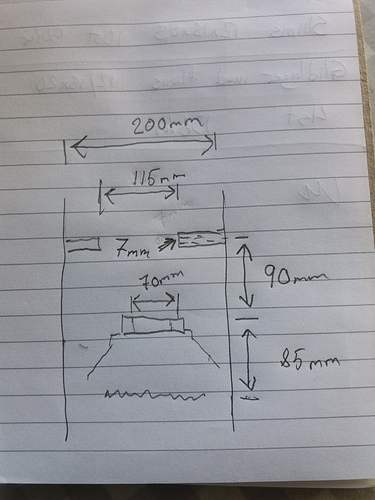Hi. It doesn’t work tomorrow, I have to move my sheep, they start to have bad bait where they are. (and you never know how long it will take to move them)
My unit is probably nothing to have on a car, is only a test if it would work, I got stuck on the filter 10-15 years ago, had tablecloths etc., then.
What I am interested in is seeing one in reality, how you have done with cyclone filters, etc.
And hope for a ride in your car, will gladly come up to Borlänge when it suits you, always need something from Biltema.
Picture of how I did inside the unit last time.
Jan, you’re welcome any time. Just give me a call to make sure I’m home.
Your gasifier does have nozzles…was the fema another build?
Ah! Ha! You were over halfway there for a working hearth core.
Building advice for protruding air jets is to make them easily replaceable. Like center drilled out SS bolts then nutted pinched into the sidewalls. Then you can tune them for different tip-to-tip spacing. Different center drilled out openings. Replace for damage.
For between and behind gasses bypassing Ben Peterson has released (imho) the best solution in between the jets inverted V channeler/focusers. Think of little house top roofs in between the air jets. With a third slope at their top ends.
Raise any hearth housing system joints at least 150/200 mm above the jets height to keep heat from killing the joints seals.
With removable jets the center choke restriction can then be a drop in plate onto a wide welded-in flange step. Either a thick drop-in like a disc brake rotor. Or a thick cut plate with a center reinforcing lip. My preference as this as it will holds and capture a deeper protecting ash slope.
Then you can easy-tune for center opening, and with height-rings even the height of that opening.
Some will still dispute this. Sigh. But ash build up WILL gas seal the drop in restrictor plate.
Once you get the core basics close then it does come down to that 75% operator experience.
Get it HOT quickly as possible! Over pull to heat it up.
Then Keep it core systems HOT with velocity maintained engine loadings.
You fine tune then with fuel wood chunks “cheating”. Cheating-the-wind is a sailing term in English, carried over to vehicle street hot-rod driving.
“Cheating” means doing unconventional things/tricks to achieve “surprise them” results.
J.O. can show you this.
Regards
Steve Unruh
Oh. The WK’s can once fully heated up long term idle use and sit, restart better.
Different gasifer animals. A bovine plodding oxen to a raging bull.
What you are making will be a lively rambunctious cart goat. Do not allow it to be a stubborn-to-use donkey.
Hi.
All the sheep at home, lucky i have 4 wheel drive car, both wet and slippery.(transported the sheep in a trailer)
We’ve had them on a field in the woods, and I’ve closed them every night and opened 5-5: 30 every morning. (Wolf Problems)
Is there any difference in pushing air into the unit or to suck the air?
Am a little worried about the fan I have, If i can press, I can have the fan on the inlet when I test.
Should I reduce the length of the nozzles, or does it matter to try?
The restriction in the bottom is loose, so I can change the diameter.
JO: That was the Dala-järna I was at, did they meet every year?
Did the gasifier this after a book I bought, where many tests from the World War 2 to 1970 exist, pretty much says how these work.
Think it is the material factory (military) that released it.
Asked about the FMEA, because I thought it looked easy to manufacture, but didn’t agree with what I read in the book.
Regards Jan
I would say the only difference is you will have a hard time make things seal with positive pressure. Not that it matters for testning purpose but it could be embarrasing in public.
I’m sure the nozzles will work the way they are, but personally I would like them shorter. Make nozzle tip circle about 20-25 cm in diameter. 10-12 cm hight from restriction to nozzles and about the same hight grate to restriction. With a 6-8 cm dia restriction and those six nozzles drilled to about 8 mm or so you’re pretty much all set for your V4.
Prefilled with thumbnail sized char 5-10 cm above nozzles and then egg sized wood chunks, or slightly smaller, you should make good gas in minutes.
Remember, a lot of shutdowns and/or light load will make ash accumulate above the grate and make the char pile restrictive.
I think so, but nothing this year and last year, that I know of. I’m not sure Ivar is still with us. If he is, he should be 85 by now.
Hi.
It seems to work this time as well, did not want to burn with the 15-year-old wood that was in, was probably too wet, but with new wood it got started.
This is how the book looks like I have, do not know if you have seen it? (348 pages A4)
Think it’s very interesting in it, especially for those of you who understand what they’re talking about.
Mvh Jan
Congratulations! Already in flaring mode 
It was hard to tell from the photos, what are the internal sizings?
I can’t tell for sure, but I may have read some of that book on the internet a few years back.
I have measured my test object, these dimensions are that something that fits a 1500cc engine of 65 hp, usually run at about 2000 rpm?
I would guess it’s pretty much in the neighbourhood. I used shorter nozzles and a 90 mm restriction for the 1800cc VW. Otherwise it’s close.
Jan,
An English translation of that book is available for download at Dr. Paul Anderson’s website.
It might also be in the driveonwood.com library? here is a link.
http://www.drtlud.com/nml-resources/BEF-BK-GeneratorGasTSEF3945.pdf

Looks great JanA
I am glad you were encouraged to give this another try.
For starting up to working conditions I strongly agree there is no difference between blower sucking a system versus pressure blowing a system.
For extended run simulations, versus IC engine sucking loading, my experiences says there is MUCH difference between blown-hearth trials and sucked-hearth trials.
Also until the IC engine is a four stroke 3 cylinders or more; again my experiences says far too much differences between constant blower trials even if sucking, and real IC engines loading use to be able to dial-in usable working down stream components like filters; collectors and settling components.
Fortunately as a see-do, what-happened, hands-on guy I have not allowed myself to be confused by should-Be’s, versus will-Be’s.
Now take what you’ve got and IC engine run with it with the absolute minimal cooling and filtration.
Use that pushrod valve, easy fix V-4 to be able to needs-to-be better fix-recovery as you step-by-step design forward. Be your whip the goat engine.
Only then once you have your good-enough ash/soot separation; cooling/condensing system evolved: only then do a valve-to-piston interference OHC engine.
This will be your shortest to-working-woodgas engine powering route.
Not my opinion. What has proven out now by the real DOW DOers.
Step-be-step idealizing with false-trails trialing will never get you there. 30 years now of “Modern’s” still lost on those false; make-Best; dead-ends; repeating “still not good enough” gas-masturbation loops.
Regards
Steve Unruh.
Thanks Jo, then maybe I should start by making a cooler, cyclone and filter.
Then I can test it on the Iller then (forwarder)
Thanks for the tip on the book, Mike R, seems to be a little different from my Swedish book.
Good evening literature.
Regards Jan
Thanks for the nice advice and tips, may try to get to the finish this time.
Tanks Steve U
Ah! Ha! You read in English.
May I suggest opening up the Library button at the top page.
Read “Auburn University Efficiency Tests” on the Wayne Kieth wood/Ag products and plastics gasified pickup truck.
Read “Drive On Wood: The Lost Art of Driving Without Gasoline” downloadable book.
Many other publications too.
Careful not to fall down into the rabbit hole of reading too much.
The three real build-it modern books I’ve purchased are all pay-for
You will want to hot-gas ash&soot cyclone/settling-chamber separate as your first step.
Then second step cool and condense you gasses.
Then third step you can actually cooled gas filter. Sheeps-wool works well for this as you do have the sheep.
Of course other sequences possible for more complexity. Forced downstream maintenance. More wet-toxic wastes produced.
Tars are handled by hearth operating with best-practices. Turn those tars into woodgas instead. And if too wet of wood used, refining-in-hearth the resulting excessive tars down into an asphalt-like road-bed/wood-treatment, by-product. Gets really complex then.
Use dry wood.
It is so much easier.
Use the IC engines heats and gas cooling systems heat to make this dried wood.
Nothing new here. The best of the German woodgases tractors on-board did this.
Steve unruh
Great advice wrapped in your unique style, Steve
Am I thinking right when I think I can use 50mm tubes from the unit to the cyclone (60hp) inlet cyclone 50x100mm, outlet cyclone 100mm?
I must have 100mm outlet?
Regards Jan
I believe 50mm ID will work just fine. I used a 30×70mm inlet and a 50mm ID outlet in a 120mm ID cyclone on the VW. I was still able to overheat the gasifier rather easily.
I don’t need to have larger outlets than inlets in the cyclone?
Does the cyclone have anything to do with overheating?
Excuse me if I ask stupid questions.
Regards Jan
No worries about questions.
What I meant was my cyclone was not restrictive enough to prevent using full capacity of the gasifier.
About cyclones. I used what I had, but I think you’re right actually. It seems they usually narrow down the inlet, compared to the outlet. Take a look at this:
http://www.gengas.nu/byggbeskrivningar/cyklon/index.shtml
Hi.
Found this cyclone,
Has anyone tried this?
What does the cone really do in a regular cyclone?
Regards Jan
